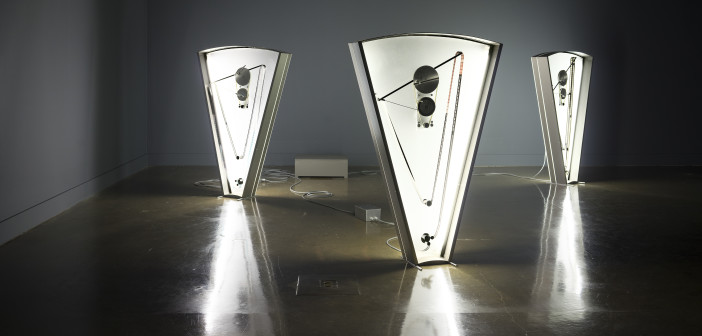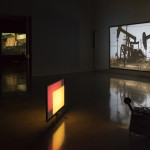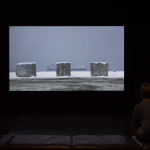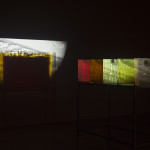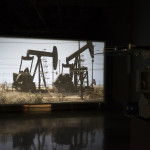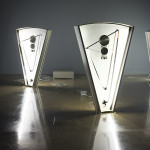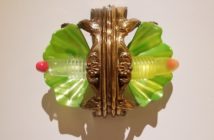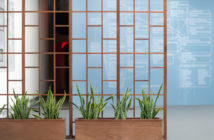Film is perhaps not the first medium that comes to mind when thinking about mimesis in visual art. Mimesis is something that painting and sculpture, for example, do well. Yet an entire gallery at the List Visual Art Center at MIT is currently full of film-based installations by the Italian artist Rosa Barba, who currently lives and works in Berlin, which deeply explore and illustrate exactly the mimetic potentials of film. Mimesis is not meant to imply an exact copy or one-to-one relationship but rather a series of patterns, made up of the striking similarity between two things. Or, in the case of a piece like Time As Perspective (2012), two things which are infinitely expandable: Projected light and image. Time As Perspective consists of a projected film, a film that serves as a nearly topographic map of oil fields and drilling equipment, and the projection equipment itself. This equipment, with its visible, shiny, silver pipe and circular film strip is an immediate mirror to the drills on the screen. An extended viewing slowly draws a relationship, hypnotically, between the rotating film loop and the rotating perspective of the image itself, further reinforced by the circular patterns of the field.
Such a relationship between film, object and image is continued by the five other pieces in this first gallery. These pieces, which range from projected film loops to more overtly sculptural pieces incorporating projectors and constructed support systems, are strongest when experienced as a whole. The installation encourages such an experience, with the auditory aspects of each piece bleeding into each other to create an immersive environment. The layers of reflected projections on the walls, floor and window of the space further highlight the interconnectedness of the pieces. Taken individually, some pieces are more successful than others; Color Studies (2013), a smaller projection situated in the middle of the gallery and made up of two projectors looping rectangles of color onto a double-sided, floor mounted, screen, is a quiet and meditative piece that is overwhelmed by its surroundings. A nearby work is distracting in its simplicity. Or seeming simplicity, given that the small silver marbles balanced on a loop of film are in a relationship to the image of that film that seems, at first, clear: The holes visible in the projected image must be a shadow, of some kind, of the spheres, and though a closer inspection reveals holes punched directly into the film, this doesn’t actually reveal much about the mechanism. The works in the first gallery are strongest in these instances of disruption, instances of disrupted relationships between image, object, mechanism and perception.
The experience of disruption, and the way such an experience is manifested through techniques of mimesis, culminates in the stunning piece Optic Ocean (2011). A large-scale screen print, Optic Ocean could be anything: A painting, as would be expected for an image on canvas; a video screen; a projection of a still or looping image. Really, it is a section of text silk-screened in red and green onto a canvas, in such a way that the colors become separated, like looking at an image through blurry 3-D glasses. This effect is magnified by the overhead spotlight illuminating the piece, providing enough light in an otherwise dark gallery to make out the text. Though the source of the text is unidentified, it makes reference to an ocean environment and details the degradation to and changes of the geological nature of the place. What is striking about the piece is the way that it makes overt references to time and space, while standing as the only fully non-temporal piece in the gallery (save for the amount of time it would take for the light to burn out). Sentences about the constantly changing relationships between bodies, how “there is no absolute,” make explicit some of the implicit questions of the other projections, as well as highlighting the differences, temporally, between experiencing a film loop and standing in front of a single image. Similarly, the way the text wraps around the canvas alludes to the possibility of Optic Ocean also being double-sided, like Time As Perspective or Color Studies.
Continuing the use of the text from Optic Ocean as well as industrial images, particularly industrial landscapes, is Somnium (2011), a film in the second gallery. The narrative of this twenty-minute film is pieced together by multiple voices, reading passages of the same text from Optic Ocean in addition to commenting on the industrial degradation of a lake, shown throughout as a snow covered landscape embedded with mechanical structures. Though the exhibition text situates this film as being “between experimental documentary and fictional narrative,” Somnium recalls mainly such films as Todd Hayne’s Safe (1995), because of the way that human bodies, environmental bodies and industries are depicted in both as interconnected and nearly indistinguishable, through the many scales bodies appear in. This play of scales, between images, landscapes and bodies, condenses in Color Out of Space, the title piece of the show, situated in the final gallery. Color Out of Space, a projection of images of stars and galaxies, through multiple panes of glass, is a thirty-six-minute meditation on the questions about perception noted herein. The audio in this piece, a series of speakers discussing the universe (particularly the way we see and depict stars and perceive the solar system) is a simultaneously frustrating and illuminating experience. The spillover from the voices in Somnium makes many of the speakers in Color Out of Space difficult to hear in their entirety, which is an obvious difficulty in any multi-film installation and a product of the space itself. In other sections, the distortion applied to some of the voices meshes beautifully with the overheard audio of Somnium, to provide as cohesive an experience as the first gallery. Providing explanations in multiple astronomical and personal registers, Color Out of Space directly addresses the question looming over the exhibition as a whole: Why and how we see what we see when trying to perceive objects, especially those larger than ourselves, and how this perception is a product of relationships between light, image, support and systems. How do we determine what needs to be seen and how to situate other objects in a scale so that those things remain visible? How do we recognize the supports in place, like the steel table that holds the panes of glass through which the projection passes, that augment our perception of images, like the blurred and blocked stars that make it onto the wall? The answers Rosa Barba provides are in the form of space and experiences of time, and the way that paying attention to such temporal experiences highlights disruptions in perception. Like a time near the end of Color Out of Space when I looked down and what was previously the plain concrete floor of the gallery suddenly revealed itself as a gray ground filled with scuffs and scratches that were both a perfect mirror to the images of stars and galaxies and a perfect moment of closure.
Rosa Barba: The Color Out Of Space is on view at the MIT List Visual Arts Center through January 3, 2016.
- Rosa Barba: The Color Out of Space Exhibition installation view at MIT List Visual Arts Center Photo: Peter Harris
- Rosa Barba: The Color Out of Space Exhibition installation view at MIT List Visual Arts Center Photo: Peter Harris
- Somnium, 2011 16mm film transferred to Blu-ray disc, color, optical sound; 19:20 min. Installation view at MIT List Visual Arts Center Photo: Peter Harris
- The Color Out of Space, 2015 High definition video, color, sound; 36 min. Installation view at MIT List Visual Arts Center Photo: Peter Harris
- Time as Perspective, 2012 35mm color film, optical sound; 12 min. Installation view at MIT List Visual Arts Center Photo: Peter Harris
- Color Clocks: Verticals Lean Occasionally Consistently Away from Viewpoints (2012) 35mm film, motors, aluminum, plexiglass Installation view at MIT List Visual Arts Center Photo: Peter Harris

